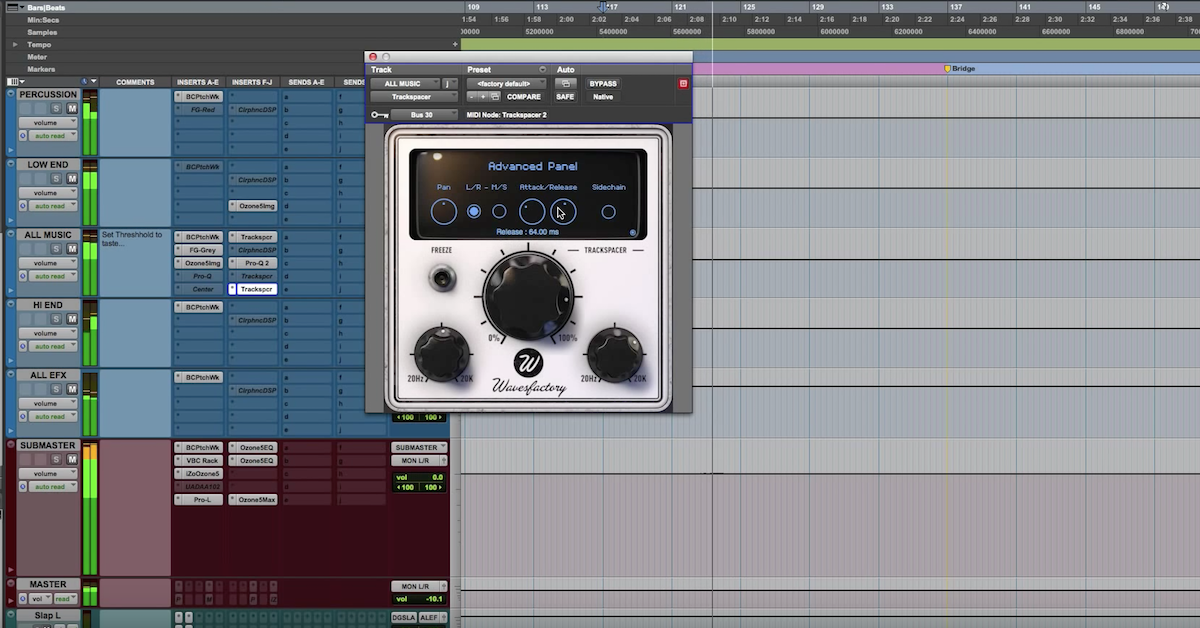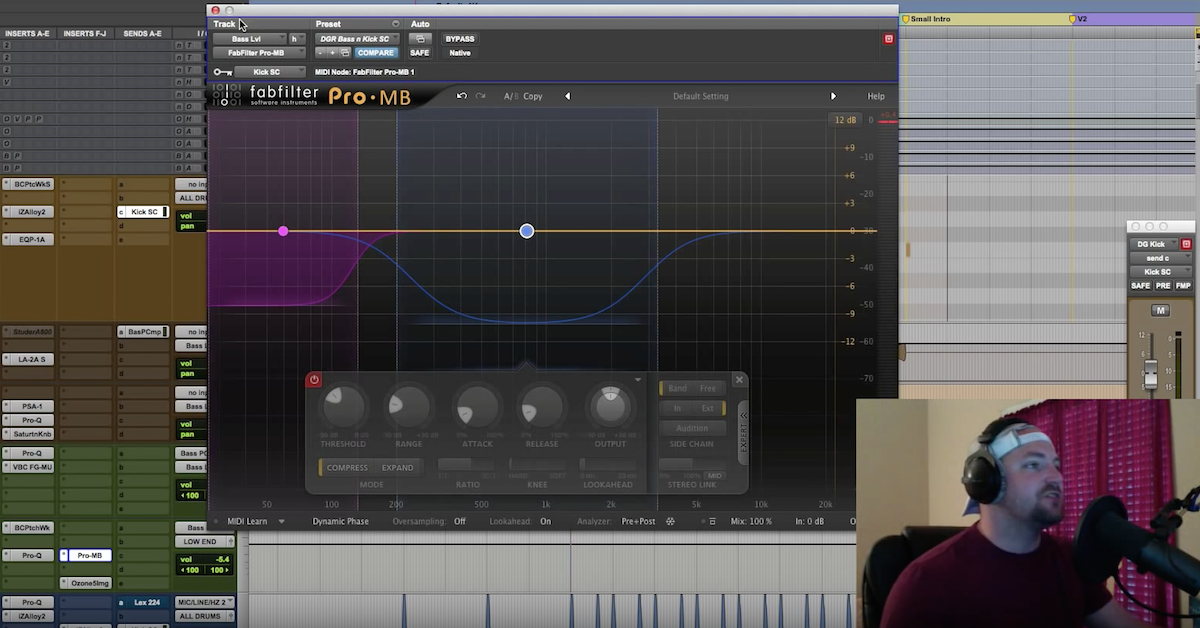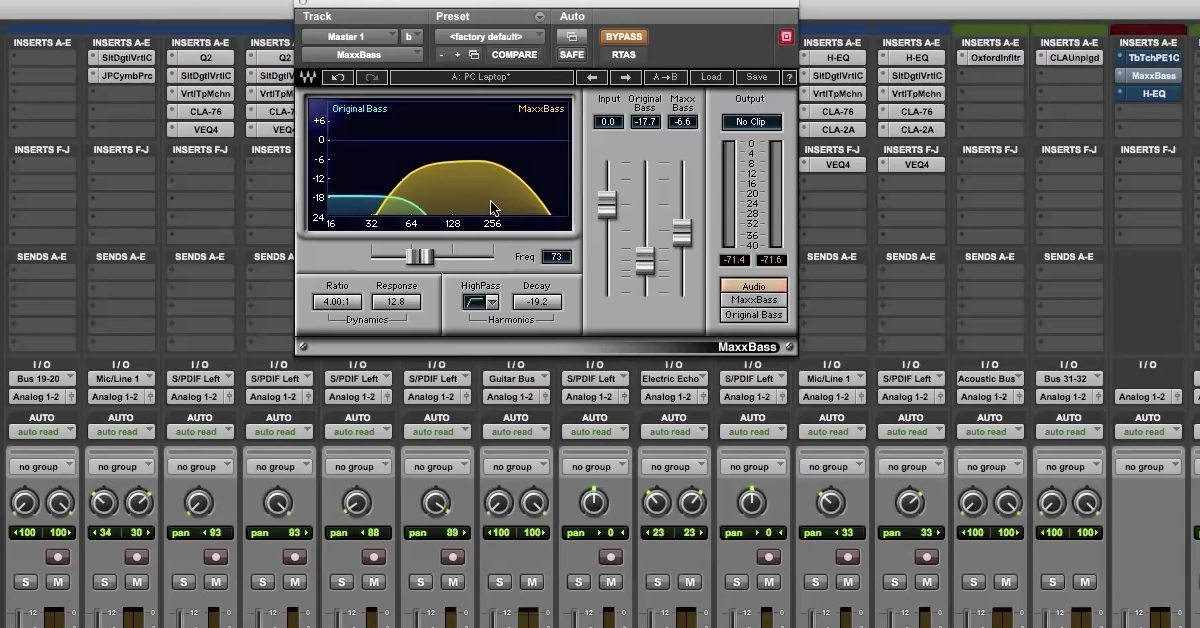Using Wavesfactory Trackspacer for Frequency-Dependant Ducking
I’m gonna talk to you about sidechain, not really sidechain compression, I don’t know if you’d call it sidechain ducking, but we’ve used the FabFilter Pro-MB, I’ve showed you that on the blog. That’s a part of the course as well. We dive deeper into that.
What I want to show you is the Wavesfactory Trackspacer. You’ll see these two bass tracks are going to a bass level. I’m gonna put that here and I’m gonna instantiate Wavesfactory Trackspacer. I’ve got my kick here, kick level there, the kick goes out via a bus called kick SC. This is the sidechain. The kick is sending into this plugin, the plugin is getting it’s information from the kick drum. Then I’m gonna be able to click this little dot, this little circle over here in the bottom corner, I’m gonna select sidechain, then dial in my attack and release.
[kick drum]
So our sidechain is set up correctly. I’m gonna exaggerate the junk out of the ratio, I’m gonna boost that quite a bit and I’m gonna take, for the kick drum and the bass, I only want a specific range to be pushed down. What this plugin essentially is gonna do is it’s gonna push down the bass based on whatever frequency range that I set, however many dB based on the ratio. So I hope I’m explaining that well, but you’ll see here the low pass is set to 20, I can leave that there. The high pass, I’m gonna pull that down somewhere in the range of 100, maybe like 110, 120, something like that. Let’s try that and then what it’s gonna do is — get rid of this menu — it’s going to push down the bass, and you’ll see a graphic here, every time the kick hits because it’s receiving the signal from the kick drum.
[kick drum sidechain + bass guitar ducking]
We’re sending a pretty conservative level, we could probably send this a little, let’s exaggerate it. Alright, now you hear kind of that pumping vibe going on so it’s pretty straight forward. I mean if you’re following me, 20 Hz to about 116 or so is getting pushed down by the kick every time the kick hits in the bass guitar. So pretty sweet way to blend in more of that low from the kick and help both of them kind of sit there.
The only thing you want to be careful of is with this, it definitely feels like a hole in your bass guitar if you aren’t gentle with it. So what I would recommend is finding the settings, coming over here, boosting it like that. You can come back in here and dial in your attack and release. Let’s set the release really long so we hear this thing just really insanely exaggerated.
[kick drum + longer release time]
You hear how there’s like no lows in the bass? That’s because the release is not coming back in time for the next kick hits. The kicks just continue to push it out of the way. If we dial in the attack quicker, we want it to be quick, and then I’d like it to be super quick. Almost like a really tight gate that’s allowing it to open and close in a way that just allows it to, just a little bit of pulse from the sub kick region in the kick drum to hit the bass down. Let’s pull this release back.
[kick ducking sub bass region of bass guitar]
I’m finding a faster release is really helping the kick come through, get it out of the way and not miss too much of that bass. And obviously this is exaggerated. So then what I recommend is dropping the percentage down to zero and then sliding it up a little bit.
[kick and bass]
Then bypass. It almost sounds kinda flat bypassed.
Something else I’m doing is I’ve got these all busses and I talk more about these in my training courses, but let’s say you had a vocal, a lead vocal, and your music was built up a bit in the 800 to 2k range where the vocal sweet spot tends to be. Say that you had your music was built up a little bit too much in that area but you liked the way the music sounds whenever the vocalist isn’t singing. You could pull in the Wavesfactory Trackspacer and set the range anywhere from the 800, 900 to 2k region, 1.5, something in there. Then dial just a hint of the ratio so that anytime the vocalist is singing she’ll push down the music in that frequency just a bit. You can get crazy with it and push it really hard, but be careful with it. Set up a buss to receive from the vocal. In this case you could do all vocals but I would probably pull open your lead vocal and send from your lead vocal into the all music.
So another handy way that you can control allowing the lead vocal to dominate that frequency range when she or he is singing, but when there are no vocals, the music can live and dominate the midrange the way that you like it.





